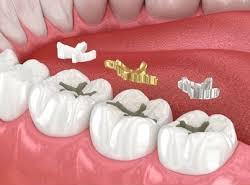Tooth fillings are a standard dental procedure used to treat cavities and restore the structure of a tooth. There are different fillings, each with its benefits and uses. Knowing about these options can help you make a well-informed decision about your dental treatment.
Let’s understand the various types of tooth restoration and fillings you can get for damaged or missing teeth.

-
Amalgam Restorations
Amalgam: Silver fillings contain metal alloys like silver, mercury, tin, and copper. They have been used in dentistry for a long time and are believed to be hard and strong.

Advantages:
- Durability: Amalgam restorations are extremely hard and can withstand the force placed on them by the teeth during chewing; thus, they can be used in molars and premolars.
- Longevity: These can last 10-15 years or more if good oral hygiene is provided and no damages are incurred through improper eating habits.
- Cost-Effective: Amalgam is more affordable than other filling materials.
Drawbacks:
- Aesthetics: Amalgam restorations are metallic, making them less appropriate for anterior teeth, which are more visible.
- Temperature Sensitivity: Amalgam, among other things, expands and contracts with temperature changes and can eventually cause tooth cracks.
Ideal Uses
When it comes to amalgam fillings, it is best to use them on the posterior teeth—the molars and premolars—because these areas often need the strength and material resilience that amalgam can provide.
2. Composite Resin Restorations
Composite resin restorative material combines plastic with a small amount of other particles. It is tooth-colored, meaning it mimics the existing teeth.

Advantages:
- Aesthetics: For this reason, composite fillings are available in various shades to match teeth’ color, especially for noticeable teeth.
- Bonding: It means that they cement directly to the tooth surfaces; thus, this offers extra strength.
- Versatility: This composite material can be used in chipped, broken, or worn teeth.
Disadvantages:
- Procedure Time: The placement process is slower because the material is applied in layers, and each layer needs to be cured with UV light.
- Cost: It is generally more costly than amalgam fillings, though this depends on the dentist’s qualifications, the location, and the type, shape, size, and placement of the tooth.
Ideal Uses
People who need fillings should opt for composite resin fillings, especially when a tooth is to be filled in an easily seen area. The material used can easily match the color of your teeth. Composite resin fillings are also used as a tactic for midsize openings.
3. Ceramic Fillings
Porcelain-filled ceramics are also other filler types that are tooth colored in nature. These are characterized by their natural look and ability to resist staining.

Advantages:
- Aesthetics: Tooth-colored ceramic fillings appear natural, and the shades can match your natural teeth.
- Durability: It is almost impossible to wear or stain them.
- Biocompatibility: Ceramic is biocompatible. It does not elicit any reactions in the patient’s body.
Disadvantages:
- Cost: Ceramic fillings are the most costly procedures.
- Brittleness: They are often less malleable than other materials, which makes the substances more easily crack under stress.
Ideal Uses
Ceramic fillings are recommended for those who want a long-lasting, natural-looking solution where the tooth or teeth will be visible, or the patient’s teeth are prone to staining.
4. Gold Fillings
Gold fillings, inlays, and onlays are made from gold alloy. They are highly durable and biocompatible.

Advantages:
- Durability: Gold can quickly turn after 20 years or more, making it the most durable type of dental filling.
- Strength: Chew forces can be with-stood effectively by them.
- Biocompatibility: Gold does not irritate the gum tissues and also is non-corrosive.
Disadvantages:
- Cost: These elaborate gold fillings are among the most costly.
- Aesthetics: The outer gold color is easily identifiable. Thus, these rings are not ideal for areas that are easily seen.
Ideal Uses
Gold fillings should be placed in the most significant loads, the molars and premolars; the cosmetic value of the teeth could be more substantial here.
5. Glass Ionomer Fillings
GIC fillings consist of a combination of glass and acrylic, commonly called silica. They are white and sealant, and the fluoride they provide prevents the tooth from further erosion. They are most widely used in restorative dentistry.
Advantages:
- Fluoride Release: They use amalgam and pave the way for releasing fluoride to avoid further decay around the filling.
- Adhesion: It is utilized in dental procedures due to its notable characteristics, such as firmly adhering to the tooth structure.
- Aesthetics: Though not as life-like as composite or ceramics, they are more cosmetic than amalgam.
Disadvantages:
- Durability: Glass ionomer fillings are comparatively less durable than other filling materials, and thus, they are recommended for stress-free areas.
- Wear and Tear: They may wear out more often than other filling materials.
Ideal Uses
Glass ionomer fillings are preferable on children’s teeth, especially the primary teeth, and on those areas of the teeth that do not bear the force of chewing. They are also applied for the following groups of patients: with root caries or as an underlying material for other types of fillings.
Conclusion
Choosing the correct type of tooth filling depends on various factors, including the location of the cavity, aesthetic preferences, budget, and the dentist’s recommendation. Ensure you ask for a comprehensive dental consultation before tooth restoration.
Let Le Sueur Family Dental Professionals Determine the Best Dental Filling for You!
Our expert dentists at Le Sueur Family Dental specialize in providing quick, comfortable, and affordable tooth fillings to restore your smile and prevent further decay. We use the latest techniques and materials to ensure a natural look and feel so you can smile with confidence again.
Book your appointment now, and let us care for your dental needs with the gentle, professional care you deserve!
You can also fill out the form here!

